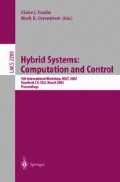Abstract
We investigate, for constrained controlled systems with impulse, the subset of initial positions contained in a set K from which starts at least one run viable in K - the hybrid viability kernel - eventually until it reaches a given closed target in finite time - the hybrid capture basin. We define a constructive algorithm which approximates this set. The knowledge of this set is essential for control problem since it provides viable hybrid feed-backs and viable runs. We apply this method for approximatingt he Minimal Time-to-reach Function in the presence of both constraints and impulses. Two examples are presented, the first deals with a dynamical system revealingthe complexity of the structure of hybrid kernels, the second deals with a Minimal Time problem with impulses.
Access this chapter
Tax calculation will be finalised at checkout
Purchases are for personal use only
Preview
Unable to display preview. Download preview PDF.
References
AUBIN J.-P. (1991) Viability Theory Birkhäuser, Boston, Basel, Berlin
AUBIN J.-P. (1999) Impulse Differential Inclusions and Hybrid Systems: A Viability Approach, Lecture Notes, University of California at Berkeley
AUBIN J.-P. & CELLINA A. (1984) Differential inclusions, Springer-Velag, Grundlehren der math. Wiss. # 264
AUBIN J.-P. & FRANKOWSKA H. (1990) Set-Valued Analysis
BENSOUSSAN A. & LIONS J.-L. (1984) Impulse control and quasivariational inequalities, Gauthier-Villars
BENSOUSSAN A. & MENALDI (1997) Hybrid Control and Dynamic Programming, Dynamics of Continuous, Discrete and Impulse Systems, 3, 395–442
CARDALIAGUET P., QUINCAMPOIX M. & SAINT-PIERRE P. (1997) Optimal times for constrained non-linear control problems without local controllability Applied Mathematics & Optimization, 36:21–42
CARDALIAGUET P., QUINCAMPOIX M. & SAINT-PIERRE P. (1999) Set-valued numerical methods for optimal control and differential games, In Stochastic and differential games. Theory and numerical methods, Annals of the International Society of Dynamical Games, 177–247 Birkhäuser
CRÜCK E. (2001) Problèmes de cible sous contrainte d’état pour des systèmes non linéaires avec sauts d’état, C.R. Acad. Sci. Paris, t. 333, Série I, p. 403–408.
DORDAN O. (1995) Analyse qualitative, Masson
DOYEN L. & SAINT-PIERRE P. (1997) Scale of viability and minimal time of crisis, Set-Valued Analysis, 5, 227–246
FRANKOWSKA H. (1991) Lower semicontinuous solutions to Hamilton-Jacobi-Bellman equations, Proceedings of 30th CDC Conference, IEEE, Brighton.
LEITMANN G., (1979) Guaranteed Asymptotic Stability for a Class of Uncertain Linear Dynamical Systems. Journ. of Optimization Theory and Applic., 27(1).
QUINCAMPOIX M. (1992) Differential inclusions and target problems, SIAM J. Control and Optimization, 30, 324–335
QUINCAMPOIX M. & VELIOV V. (1998) Viability with a target: theory and applications, in Applications of math. in engineering, 47–54, Heron Press
SAINT-PIERRE P., (1994) Approximation of the Viability Kernel, Applied Mathematics & Optimization, 29 (1994), 187–209.
SAINT-PIERRE P., (1996) Equilibria and stability in setvalued analysis: a viabili-ty approach. Topology in nonlin. Analysis, Banach Center Pub. 35, 243–255 Warsaw
SEUBE N. (1995) Robust Stabilization of Uncertain Systems. Journal of Math. Analysis and Applications, 452–466.
SHAFT (van der) A. & SCHUMACHER H. (1999) An introduction to hybrid dynamical systems, Springer-Verlag, Lecture Notes in Control, 251
SASTRY S., (1999) Non Linear Systems. Analysis, Stability and Control, Springer-Verlag.
VAANDRAGER F.W. & VAN SCHUPPEN J.H. (1999) Hybryd Systems: Computation and ControL Vol 1569 of LNCS. Springer-Verlag. Berlin.
ZABCZYK J. (1973) Optimal Control by means of switching Studia Mathematica, 65, 161–171
Author information
Authors and Affiliations
Editor information
Editors and Affiliations
Rights and permissions
Copyright information
© 2002 Springer-Verlag Berlin Heidelberg
About this paper
Cite this paper
Saint-Pierre, P. (2002). Hybrid Kernels and Capture Basins for Impulse Constrained Systems. In: Tomlin, C.J., Greenstreet, M.R. (eds) Hybrid Systems: Computation and Control. HSCC 2002. Lecture Notes in Computer Science, vol 2289. Springer, Berlin, Heidelberg. https://doi.org/10.1007/3-540-45873-5_30
Download citation
DOI: https://doi.org/10.1007/3-540-45873-5_30
Published:
Publisher Name: Springer, Berlin, Heidelberg
Print ISBN: 978-3-540-43321-7
Online ISBN: 978-3-540-45873-9
eBook Packages: Springer Book Archive

